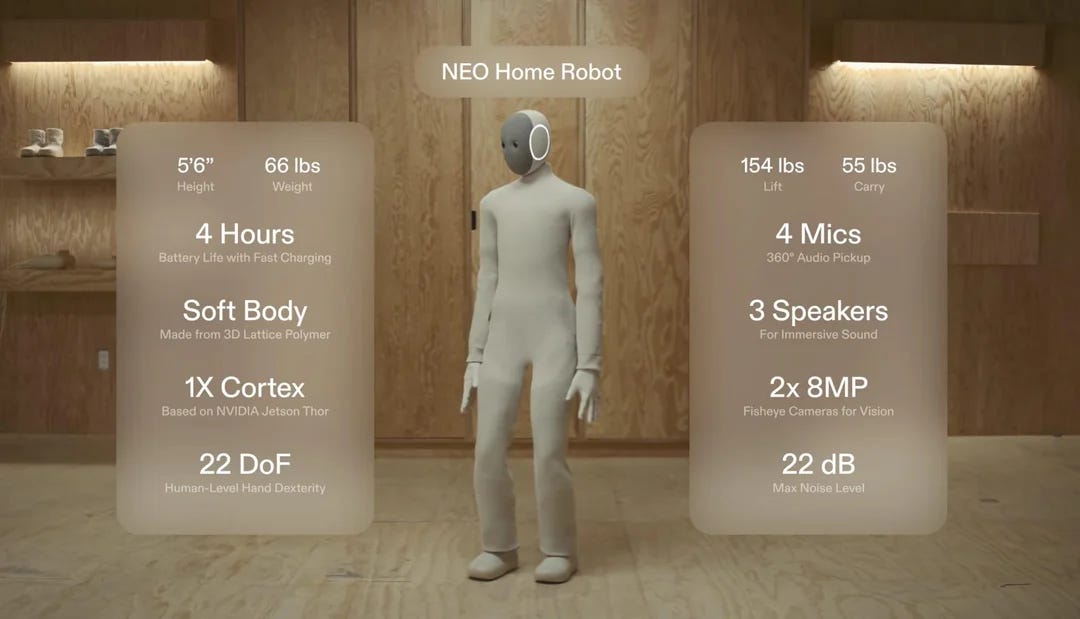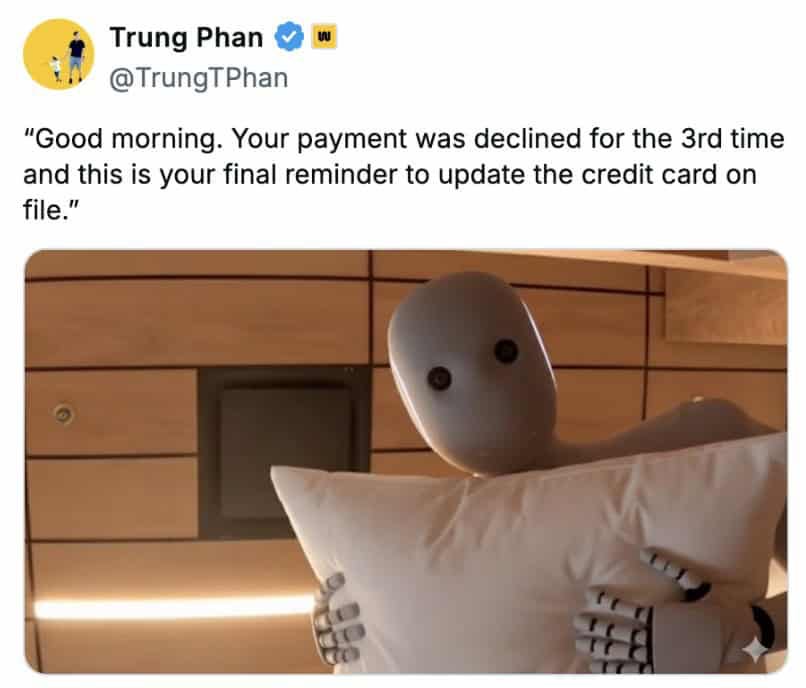Personal AI Robots & AI Hardware You Can Buy Now
Trends, prospects, and obstacles of the AI robotics industry
Today, we have something that could free us (or not?) from the most boring part of our life — chores. Neo is here, and X (formerly Twitter) is flooded with memes about a new home robot designed to help around the house. I got really curious to dig into what’s inside this robot, because this fusion of vision, language understanding, and action already triggers wide-ranging changes in the industry.
In this article, we:
Elaborate on Neo and compare it to its alternatives
Discover the actual state of personal AI robots
Recommend 5 AI devices worth considering now.
Let’s go.
I, Robot — What is NEO and Why Everyone is Talking about It
Not capable of writing a symphony yet, Neo is a Humanoid Home Robot, created to take over routine household tasks — from cleaning and laundry to interacting with the elderly and children. The robot is capable of carrying loads of up to 25 kg, opening doors, and manipulating objects on the floor or table. Seems to me like a flying start.
Neo is connected to the mobile app, so it is expected that people create to-do lists and set the time there.
Behind his eyes:
Redwood AI, 1X’s own vision-language large language model that can process camera data, gestures, and surroundings (we will come back to this surveillance below).
It remembers things and understands both voice and visuals, so it gets what’s going on. Like this, you can even chat with him, not only about cleaning.
Neo adapts to new environments and develops skills that weren’t intended by the developers.
The soft body keeps noise down. It has built-in Wi-Fi, Bluetooth, and 5G, plus speakers in the torso and chest so you can play music through it.
Sadly, the battery runs for up to 4 hours, but keeps an eye on its own charge and plugs itself in when needed!
While some people are dreaming of him doing their dishes, others are churning out memes.
Who’s the creator
These cute robots belong to 1X, an AI and robotics company, founded in 2014 by Bernt Bornich in Norway. Now they have the HQ in California, attracting specialists from all over the world.
The story began in 2018, when they unveiled Revo1 — a lightweight but powerful servo motor that gives robots stronger and smoother joint movements.
It’s not by chance that I mention it, because it took only 5 years till in 2023 the NEO Project was born. After proving that EVE, a wheeled humanoid robot, worked great in factories, the company switched to making friendly human-like helpers for homes.
In 2025, the company presented NEO Gamma, an updated and home-optimized version of NEO. And it looks like they’re not slowing down. In 2026, 1X plans to bring NEO into real customer homes through a wider Early Access rollout.
AI Helpers or Home Spies?
But even if you drop 20k on that robot, you accept the fact that operators can tap into its cameras to handle tricky tasks, gather data, and train the AI. According to the devs, it’s the only way to improve it.
It’s not 24/7 spying, more like scheduled or on-demand sessions. The robot auto-blurs everyone’s faces, and you can mark bedrooms, bathrooms, and other private spaces as no-go zones through the app. But still...the internet is already making fun of how it is creepy.
Anyway, no other company has reached this milestone. Not Tesla with Optimus, not Figure, not Unitree. 1X is moving from the demo stage to consumer preorders.
State of Personal AI Robots
Humanoid robots are nothing new, but I get why people are freaking out. Neo took a step forward toward the creatures that we’ve only seen in movies. I think you remember that the same thing happened with Boston Dynamics’ robot dogs, which kept the buzz going for years.
As you can see from the table below, Tesla Optimus and Figure 02 are the main competitors of 1X NEO with LLM under the hood, but both are ultimately focused on large-scale task optimization, even though Figure 02 is also trying to position itself as a potential home robot.
The main difference is that NEO is indeed carving out a different niche, which is, let's be honest, quite risky.
What does “сonsumer-ready humanoid robot” even mean today?
So the company claims that it’s the world’s first home humanoid robot. It’s not a regulated label, just another level.
What sets NEO apart from other humanoids:
Soft materials and fall detection sensors make it safe around kids, pets, and elders. You’re not gonna worry about a metal machine knocking over your toddler.
It can handle actual home tasks in messy environments, like the kitchen, not some clean factory floors
It’s available for regular people to buy (well, preorder), not just for factories or labs.
The reality is that Neo is not yet fully autonomous and still relies on teleoperation. I’m sure it’s going to take some time before a robot does most household stuff on its own. Think about it - every apartment is different, stairs are a nightmare, and we are asking one machine to handle everything.
The potential is huge, not even a question. And AI is growing like crazy right now, so watching this transition play out is super interesting. But this niche is in an awkward phase, where robots show promise but aren’t so attractive. The real test is whether these robots can adapt to unpredictable homes without constant human help (and don’t judge us for the mess in our apartment).
Anyway, the game has already changed. Who knows, maybe Musk will surpass this success.
Trends and prospects of AI robots
Well, the population’s getting older, and at the same time, there’s a growing shortage of workers, so we see that the demand is going to shoot up. The Global Automation: Humanoid Robot — The AI Accelerant report backs that up, too. They say the market could hit around $38 billion by 2035 thanks to faster AI progress, cheaper components, and ramped-up production.
Of course, we’ll still have to deal with all the ethical stuff — like how people feel about robots and how much freedom they should have — but I don’t doubt that in the next few years, we’ll start seeing them take over jobs that are too risky for humans, like mining or chemical plants, and also in elderly care.
We’re heading straight toward AI-native factories where AI robots and systems run every step of production. Take Xiaomi’s Changping facility, which is an 86,000-square-meter plant running on 100% automation through the HyperIMP platform.
Picture factories with no lights or people (for me, it still sounds scary). They even have a name, “lights-out manufacturing”. The pitch that we will save energy, but are we counting what the robots and AI actually consume?
But on the flip side, microfactories are taking off. Perhaps you heard people talk about local production being hard to organize, but apparently, AI can solve this. A human handles only tricky stuff, while AI does the rest.
The MicroFactory DevKit shows you exactly what this looks like. A robot that works as a mini-factory you drop in your basement, garage, or office.
We have already mentioned in the YC AI Startup F25 Batch post that startups are getting thinner, often built by teams of 3-5 members. The same thing is actually happening in the hardware building. One founder with a few right AI tools that train and run on autopilot can build something real. But I truly believe that the real value is being around others who make things happen. Communities like Blueprint get this. They give folks tools, labs, and energy to keep creating projects that might end up being another project like NEO one day.
Check out their Founders Inc Demo Day, where young teams and solo builders pitch their stuff. A ton of geek hardware projects showed up: AI companions, autonomous surgical robots, AI cooking robots for your kitchen, AI receptionists booking appointments, and a whole bunch of other wild stuff.
AI robots are clearly not just big metal helpers; they are also devices that are changing how we live and work. Tech stores are full of products with the “AI” label, from smart assistants to home gadgets and factory bots.
Below, we will break down tools that are already part of our everyday life, and you can actually try them.
AI devices worth considering now
Starting with the most popular AI gadgets, we move up to the more advanced stuff. From smart glasses to personal AI robots, here’s a handpicked list of tech you can actually use.




